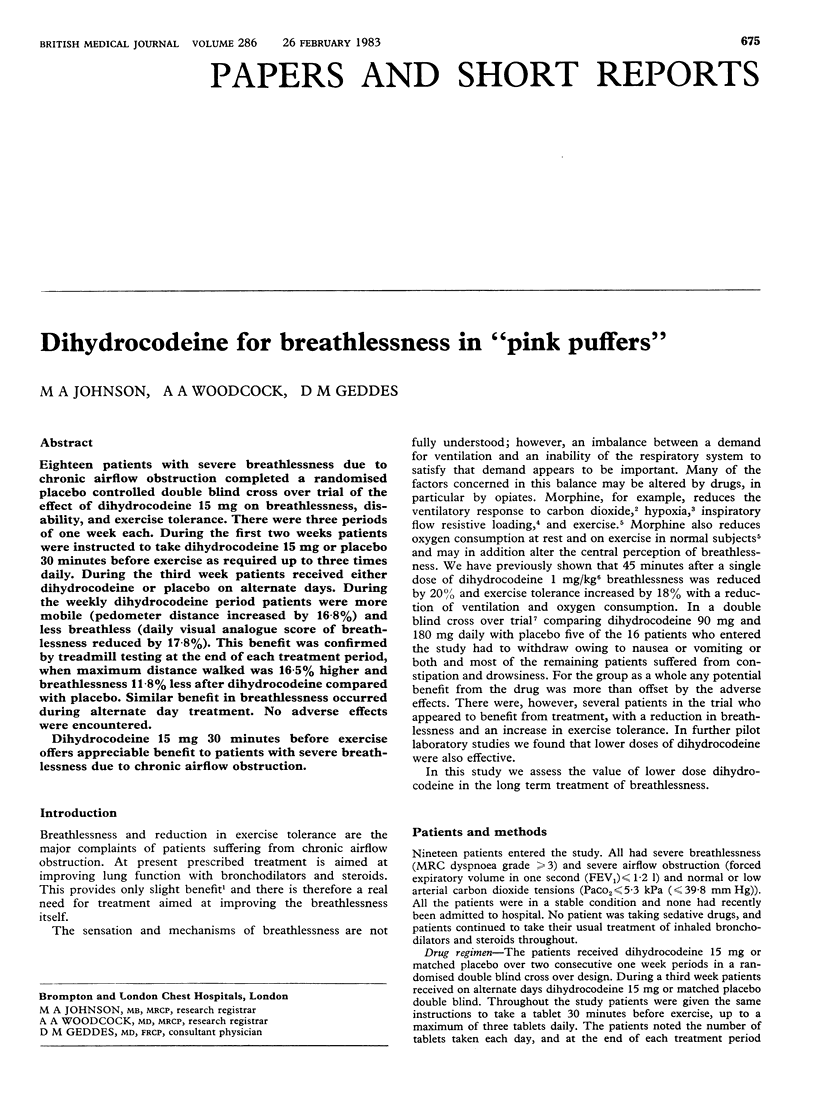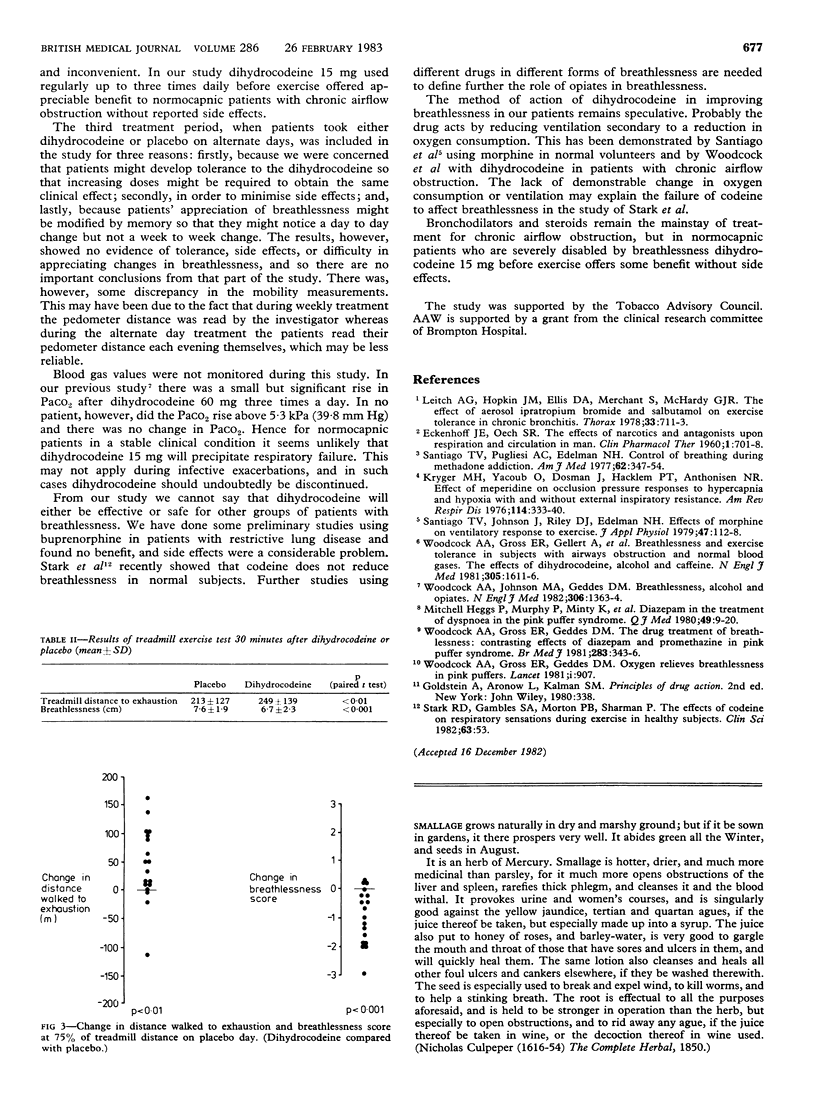Abstract
Eighteen patients with severe breathlessness due to chronic airflow obstruction completed a randomised placebo controlled double blind cross over trial of the effect of dihydrocodeine 15 mg on breathlessness, disability, and exercise tolerance. There were three periods of one week each. During the first two weeks patients were instructed to take dihydrocodeine 15 mg or placebo 30 minutes before exercise as required up to three times daily. During the third week patients received either dihydrocodeine or placebo on alternate days. During the weekly dihydrocodeine period patients were more mobile (pedometer distance increased by 16.8%) and less breathless (daily visual analogue score of breathlessness reduced by 17.8%). This benefit was confirmed by treadmill testing at the end of each treatment period, when maximum distance walked was 16.5% higher and breathlessness 11.8% less after dihydrocodeine compared with placebo. Similar benefit in breathlessness occurred during alternate day treatment. No adverse effects were encountered. Dihydrocodeine 15 mg 30 minutes before exercise offers appreciable benefit to patients with severe breathlessness due to chronic airflow obstruction.
Full text
PDF


Selected References
These references are in PubMed. This may not be the complete list of references from this article.
- Bar-Or D., Marx J. A., Good J. Breathlessness, alcohol, and opiates. N Engl J Med. 1982 Jun 3;306(22):1363–1364. doi: 10.1056/NEJM198206033062214. [DOI] [PubMed] [Google Scholar]
- De Jong P. E., De Jong-van den Berg L. T., De Zeeuw D., Donker A. J., Schouten H., Statius van Eps L. W. The influence of indomethacin on renal concentrating and diluting capacity in sickle cell nephropathy. Clin Sci (Lond) 1982 Jul;63(1):53–58. doi: 10.1042/cs0630053. [DOI] [PubMed] [Google Scholar]
- Kryger M. H., Yacoub O., Dosman J., Macklem P. T., Anthonisen N. R. Effect of meperidine on occlusion pressure responses to hypercapnia and hypoxia with and without external inspiratory resistance. Am Rev Respir Dis. 1976 Aug;114(2):333–340. doi: 10.1164/arrd.1976.114.2.333. [DOI] [PubMed] [Google Scholar]
- Leitch A. G., Hopkin J. M., Ellis D. A., Merchant S., McHardy G. J. The effect of aerosol ipratropium bromide and salbutamol on exercise tolerance in chronic bronchitis. Thorax. 1978 Dec;33(6):711–713. doi: 10.1136/thx.33.6.711. [DOI] [PMC free article] [PubMed] [Google Scholar]
- Mitchell-Heggs P., Murphy K., Minty K., Guz A., Patterson S. C., Minty P. S., Rosser R. M. Diazepam in the treatment of dyspnoea in the 'Pink Puffer' syndrome. Q J Med. 1980 Winter;49(193):9–20. [PubMed] [Google Scholar]
- Santiago T. V., Johnson J., Riley D. J., Edelman N. H. Effects of morphine on ventilatory response to exercise. J Appl Physiol Respir Environ Exerc Physiol. 1979 Jul;47(1):112–118. doi: 10.1152/jappl.1979.47.1.112. [DOI] [PubMed] [Google Scholar]
- Santiago T. V., Pugliese A. C., Edelman N. H. Control of breathing during methadone addiction. Am J Med. 1977 Mar;62(3):347–354. doi: 10.1016/0002-9343(77)90831-2. [DOI] [PubMed] [Google Scholar]
- Woodcock A. A., Gross E. R., Geddes D. M. Drug treatment of breathlessness: contrasting effects of diazepam and promethazine in pink puffers. Br Med J (Clin Res Ed) 1981 Aug 1;283(6287):343–346. doi: 10.1136/bmj.283.6287.343. [DOI] [PMC free article] [PubMed] [Google Scholar]
- Woodcock A. A., Gross E. R., Geddes D. M. Oxygen relieves breathlessness in "pink puffers". Lancet. 1981 Apr 25;1(8226):907–909. doi: 10.1016/s0140-6736(81)91612-3. [DOI] [PubMed] [Google Scholar]
- Woodcock A. A., Gross E. R., Gellert A., Shah S., Johnson M., Geddes D. M. Effects of dihydrocodeine, alcohol, and caffeine on breathlessness and exercise tolerance in patients with chronic obstructive lung disease and normal blood gases. N Engl J Med. 1981 Dec 31;305(27):1611–1616. doi: 10.1056/NEJM198112313052703. [DOI] [PubMed] [Google Scholar]


